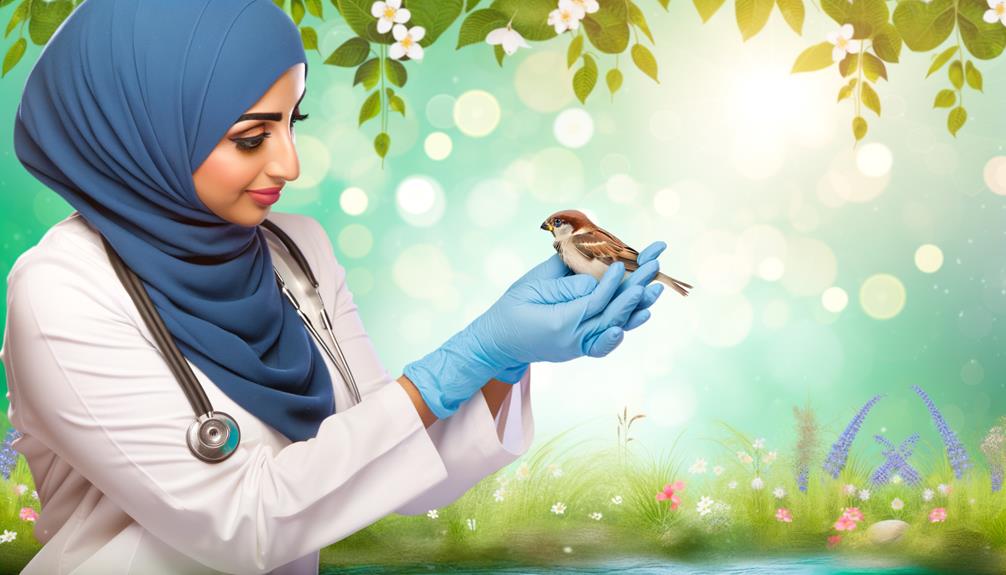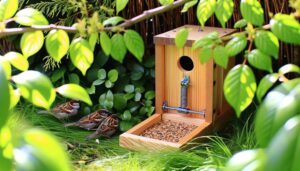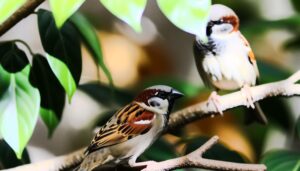10 Steps to Euthanize House Sparrows Humanely
Euthanizing house sparrows requires strict adherence to ethical and legal standards to guarantee humane treatment and regulatory compliance. First, correctly identify the species to avoid harm to protected birds.
Utilize humane capture methods such as mist nets or cage traps. Approved euthanasia methods include CO2 chambers and cervical dislocation, executed by trained personnel.
Guarantee complete death by confirming the absence of essential signs. Properly dispose of carcasses in biohazard containers to mitigate health risks.
Prevent reinfestation by sealing entry points and managing food sources. Understanding these steps can help maintain both ecological and ethical responsibilities effectively.

Key Takeaways
- Ensure accurate identification of house sparrows to avoid euthanizing protected species.
- Use humane capture methods like mist nets or cage traps to minimize stress.
- Employ CO2 chambers or cervical dislocation devices administered by trained personnel.
- Adhere to ethical principles and legal regulations to ensure humane treatment.
- Dispose of carcasses properly by sealing them in leak-proof bags and using approved biohazard containers.
Ethical Considerations
When assessing the ethical considerations of euthanizing house sparrows, it is vital to weigh the moral implications against ecological and societal impacts.
House sparrows, an invasive species in many regions, can greatly disrupt local ecosystems by outcompeting native birds for resources. Ethically, the act of euthanizing these birds is considered in relation to the potential benefits to biodiversity and the protection of native species.
Additionally, societal perspectives on animal welfare must be taken into account, ensuring that methods used are humane and minimize suffering. Balancing these factors involves a nuanced evaluation, recognizing the invasive nature of house sparrows while adhering to humane treatment principles.
Understanding these ethical dimensions is important for making informed and balanced decisions regarding their population management.
Legal Regulations
Legal regulations surrounding the euthanization of house sparrows are governed by a complex framework of environmental, wildlife, and animal welfare laws. Compliance with these regulations is crucial to guarantee ethical and legal adherence.
Key considerations include:
- Permits: Securing necessary permits to legally euthanize house sparrows.
- Methods: Adhering to approved euthanasia methods to ensure humane treatment.
- Protected Species: Confirming that the species is not safeguarded under local or international laws.
- Documentation: Maintaining detailed records of euthanasia activities for accountability.
- Penalties: Understanding the legal ramifications for non-compliance, which can include hefty fines and legal action.
These regulations are designed to balance the need for population control with the welfare of the individual animals involved.
Identifying House Sparrows
Accurate identification of house sparrows (Passer domesticus) is fundamental to guarantee that efforts are legally compliant and targeted towards the correct species. House sparrows can be distinguished by their stout bodies, measuring approximately 16 cm in length, with a wingspan of around 21 cm.
Males exhibit distinct black bibs, white cheeks, and chestnut napes. Females and juveniles, however, lack the black bib and feature more subdued brown and grey plumage with streaked backs. Their vocalizations are characteristic, consisting of a series of chirps and cheeps.
Observing these morphological and auditory traits in combination with their common habitats, such as urban and suburban areas, facilitates accurate identification, ensuring that conservation efforts are appropriately directed.
Necessary Equipment
When addressing the necessary equipment for euthanizing house sparrows, it is important to take into account both humane capture methods and appropriate euthanasia tools.
Humane capture methods may include mist nets or cage traps that minimize stress and injury to the birds.
Appropriate euthanasia tools should comply with ethical guidelines and guarantee a swift, painless death, such as CO2 chambers or cervical dislocation devices.
Humane Capture Methods
To guarantee the humane capture of house sparrows, it is vital to utilize equipment specifically designed to minimize stress and harm to the birds. Effective capture methods hinge on the appropriate selection and usage of tools that prioritize the well-being of the birds during the capture process.
Recommended equipment includes:
- Mist Nets: Fine mesh nets that entrap birds without causing injuries.
- Hawk Traps: Cage traps with a one-way entry designed to safely contain captured birds.
- Drop Traps: Mechanisms that enclose birds in a controlled manner when triggered.
- Hand Nets: Soft mesh nets for gently catching individual birds.
- Holding Cages: Spacious, ventilated cages for temporary containment.
Employing these tools ensures the capture of house sparrows is conducted with the utmost care and respect for their welfare.
Appropriate Euthanasia Tools
Selecting the appropriate euthanasia tools is crucial to guaranteeing the procedure is both humane and effective. Essential equipment includes a small, airtight chamber for administering carbon dioxide (CO2), which is widely regarded as a humane method.
The chamber should be equipped with a gas regulator to control CO2 flow, guaranteeing gradual induction to minimize distress. Additionally, cervical dislocation can be employed as an alternative method, requiring specialized training to perform correctly and humanely.
Tools such as a cervical dislocation device, which provides a swift and precise application, should be used. Adequate personal protective equipment (PPE) such as gloves and face masks are recommended to ensure safety during the procedure. Proper tool selection and usage are paramount to achieving humane euthanasia.
Humane Methods
In addressing humane methods for euthanizing house sparrows, it is essential to weigh ethical guidelines that prioritize minimizing suffering.
Approved euthanasia techniques, such as cervical dislocation or CO2 inhalation, are evaluated based on their efficacy and humaneness.
These methods must be implemented by trained personnel to guarantee adherence to ethical standards and regulatory compliance.
Ethical Considerations
When considering the euthanasia of house sparrows, it is important to evaluate the ethical implications and make sure that humane methods are utilized to minimize suffering. Ethical considerations necessitate adherence to humane principles, making certain that the procedure is conducted with the utmost respect for the life being ended.
Key ethical principles include:
- Minimizing Pain: Making sure that the method chosen causes the least amount of pain possible.
- Quick and Efficient: The procedure should be swift to prevent prolonged distress.
- Respect for Life: Acknowledging the intrinsic value of the bird's life, despite its pest status.
- Responsibility: Those performing the euthanasia should be trained and knowledgeable.
- Legal Compliance: Adhering to all laws and regulations regarding the humane treatment of animals.
These factors collectively guarantee a compassionate approach to euthanasia.
Approved Euthanasia Techniques
To secure humane euthanasia of house sparrows, it is vital to employ approved techniques that align with ethical standards and regulatory guidelines.
The American Veterinary Medical Association (AVMA) recommends methods such as carbon dioxide (CO2) exposure and cervical dislocation.
CO2 exposure involves placing the bird in a chamber with gradually increasing CO2 levels, leading to unconsciousness and death without distress.
Cervical dislocation, performed by trained personnel, guarantees rapid loss of consciousness and minimal suffering.
Both methods require adherence to precise protocols to secure efficacy and humane treatment.
Proper training and adherence to these guidelines are essential to minimize pain and distress, ensuring the process is both ethical and effective.
Step-by-Step Process
Initiating the euthanasia process for house sparrows requires adherence to a series of precise and humane steps to guarantee the procedure is both effective and ethical. To start, prepare the necessary equipment and make sure it is in proper working order.
Capture the bird gently and securely to minimize stress and injury. Administer the chosen euthanasia agent according to established guidelines for dosage and method.
Monitor the bird for signs of distress or incomplete euthanasia, intervening if necessary. Finally, confirm death through the absence of essential signs.
- Prepare equipment: Ensure all tools are ready and functional.
- Capture gently: Minimize stress and injury.
- Administer agent: Follow guidelines strictly.
- Monitor bird: Watch for distress.
- Confirm death: Check for absence of essential signs.
Disposal Procedures
Initially, place the carcasses in a sealed, leak-proof plastic bag to prevent any fluid leakage. Double-bagging is recommended for added security.
Next, label the bag with pertinent information such as the date and method of euthanasia.
Dispose of the bag in an approved biohazard container or take it to a facility that handles animal remains, such as a veterinary clinic or local animal control service.
Avoid burying or composting the carcasses, as this may lead to potential health risks and environmental hazards.
Always follow local regulations and guidelines for animal disposal to guarantee compliance and safety.
Preventing Reinfestation
Implementing effective measures to prevent reinfestation of house sparrows requires a thorough understanding of their nesting and feeding habits. House sparrows are highly adaptable, often exploiting small openings in buildings and feeding on readily available food sources.
To mitigate reinfestation, consider the following strategies:
- Seal entry points: Close gaps and holes in buildings where sparrows may nest.
- Remove food sources: Guarantee waste is properly managed and bird feeders are inaccessible to sparrows.
- Install bird deterrents: Utilize spikes, nets, and other physical barriers to deter nesting.
- Regular monitoring: Conduct frequent inspections to detect early signs of infestation.
- Habitat modification: Alter the environment to make it less attractive to sparrows, such as trimming vegetation.
These methods collectively reduce the likelihood of sparrow reinfestation.
Conclusion
In summation, the euthanasia of house sparrows requires adherence to ethical standards, compliance with legal regulations, precise identification, and utilization of appropriate equipment. Employing humane methods guarantees the process is carried out with minimal suffering.
A step-by-step approach provides clarity and accuracy, while proper disposal procedures uphold sanitary conditions. Preventive measures are essential to mitigate future infestations.
Consequently, the confluence of ethics, legality, and precision forms the cornerstone of responsible avian population management.






